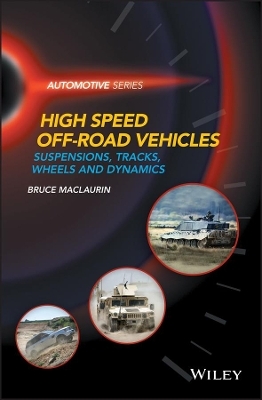
Design of High Speed Off-Road Vehicles
John Wiley & Sons Inc (Verlag)
9781119258780 (ISBN)
- Lieferbar (Termin unbekannt)
- Versandkostenfrei
- Auch auf Rechnung
- Artikel merken
Bruce Maclaurin initially worked in the aircraft industry on structural design and analysis and then spent over 35 years on the research and design of the automotive systems of military vehicles. His main area of research is tracked and wheeled vehicle steering systems, suspensions and tracks including design, computer modelling, and performance measuring. He is now retired from the Ministry of Defence in the UK.
Series Editor s Preface
Acknowledgements
Introduction
1. Tracked Vehicle Running Gear and Suspension Systems
1.1 General Arrangement
1.2 Transverse Torsion Bars
1.3 Coil Springs
1.4 Hydrogas Suspensions
1.4.1 Challenger MBT Hydrogas Unit
1.4.2 Measured Characteristics of Challenger Unit
1.4.3 Temperature Effects
1.4.4 Other Types of Hydrogas Suspension
1.5 Dampers
1.5.1 Hydraulic Dampers
1.5.2 Friction Dampers
2. Vehicle Track Systems
2.1 Link Tracks
2.1.1 Single-Pin Tracks
2.1.2 Double-Pin Tracks
2.1.3 Rubber Track Pads, Road Wheels and Track Tensioners
2.1.4 Track Loadings
2.1.5 Rolling Resistance: Analytical Methods
2.1.6 Rolling Resistance: Experimental Measurements
2.1.7 Noise and Vibration of Track Systems
2.1.8 Approaches for Reducing Noise and Vibration
2.1.9 Reducing Noise and Vibration
2.2 Flexible Tracks
2.2.1 Earlier Flexible Tracks
2.2.2 Contemporary Flexible Tracks
2.2.3 Proof of Principle Flexible Tracks for Spartan APC
2.2.4 Later Developments
3. Tracked Vehicle Suspension Performance: Modelling and Testing
3.1 Human Response to Whole-Body Vibration and Shock
3.1.1 BS 6841:1987 and ISO 2631-1 (1997)
3.1.2 Further Standards Relating to WBV
3.2 Terrain Profiles
3.2.1 Characterisation
3.2.2 DERA Suspension Performance Test Courses
3.2.3 Response of Multi-Wheel Vehicles
3.2.4 Quarter-Car Model
3.2.5 Computer Modelling
3.2.6 Ride Performance Trials of a Challenger Suspension Test Vehicle
3.2.7 Pitch Response to Braking and Accelerating
3.2.8 Sprung Idler Test Vehicle (SITV)
4. Controllable Suspensions
4.1 Height and Attitude Control
4.1.1 Tracked Vehicles
4.1.2 Wheeled Vehicles
4.2 Actively Controlled Damping (Semi-Active Suspensions)
4.2.1 Adaptive Damping
4.3 Active Suspension Systems
4.4 DERA Active Suspension Test Vehicles
4.4.1 Narrow-Bandwidth Systems
4.4.2 Broad-Bandwidth System
4.5 Conclusions
5. Wheeled Vehicle Drivelines and Suspensions
5.1 Unarmoured Vehicles
5.1.1 Leyland DAF DROPS 8 e6 Logistic Load Carrier
5.1.2 MAN SX 88 High-Mobility Load Carrier
5.1.3 Pinzgauer 4 e4 and 6 e6 Light Trucks
5.1.4 Range Rover
5.1.5 Alvis Stalwart
5.1.6 Caterpillar Mining/Dump Truck
5.1.7 Euclid (Later Hitachi) Mining/Dump Trucks
5.2 Armoured Vehicles
5.2.1 H-Drive
5.2.2 I-Drive
5.3 Interconnected Suspensions
5.3.1 Methods of Interconnection
6. Wheeled Vehicle Suspension Performance
6.1 Quarter-Car model
6.2 Wheelbase Filter
6.3 DROPS Truck Ride Measurements
7. Steering Performance of Tracked and Wheeled Vehicles
7.1 Tracked Vehicles
7.1.1 Skid Steering Mechanisms
7.1.2 Skid Steering Models
7.1.3 The Magic Formula
7.1.4 Deriving the Magic Formula Parameters for the Track
7.1.5 Steering Performance Model
7.1.6 Results from the Model
7.2 Comparing Skid and Ackermann Steered Wheeled Vehicles
7.2.1 Tyre Force Slip Data
7.2.2 Choice of the Tyre Model
7.2.3 Results from the Model
7.2.4 Ackerman Steered Vehicle Model
7.2.5 Model Results
7.2.6 Torque Vectoring
Appendix A Equations of Motion
Appendix B Power Flow Equations
8. Soft-Soil Performance of Wheeled and Tracked Vehicles
8.1 Basic Requirements
8.1.1 Soil
8.1.2 Basic Definition
8.1.3 Soil Vehicle Models
8.2 Models for Soft Cohesive Soils
8.2.1 Vehicle Cone Index (VCI) Model
8.2.2 WES Mobility Number Model
8.2.3 Mean Maximum Pressure (MMP)
8.2.3 Vehicle Limiting Cone Index (VLCI)
8.3 Models for Dry Frictional Soils
8.3.1 WES Mobility Number for Wheeled Vehicles
8.3.2 DERA Vehicle Trials
8.4 Space Efficiency of Running Gear Systems for Armoured Vehicles
8.5 Tractive Force Slip Relationship for Tyres in Soft Cohesive Soils
8.5.1 Describing Force Slip Characteristics
8.5.2 The Magic Formula
8.5.3 Development of the Modified Magic Formula
9. Effect of Free, Locked and Limited-Slip Differentials on Traction and Steering Performance
9.1 Types of Lockable and Limited-Slip Differentials
| Erscheinungsdatum | 04.10.2018 |
|---|---|
| Reihe/Serie | Automotive Series |
| Verlagsort | New York |
| Sprache | englisch |
| Maße | 170 x 244 mm |
| Gewicht | 596 g |
| Themenwelt | Technik ► Fahrzeugbau / Schiffbau |
| Technik ► Maschinenbau | |
| ISBN-13 | 9781119258780 / 9781119258780 |
| Zustand | Neuware |
| Informationen gemäß Produktsicherheitsverordnung (GPSR) | |
| Haben Sie eine Frage zum Produkt? |
aus dem Bereich


